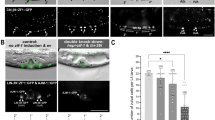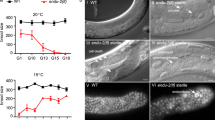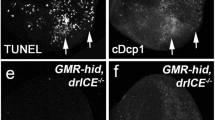Abstract
THE glp-1 and lin-12 genes encode homologous transmembrane proteins that may act as receptors for cell interactions during development3,4. The glp-1 product is required for induction of germ-line proliferation and for embryogenesis3,5. By contrast, lin-12 mediates somatic cell interactions, including those between the precursor cells that form the vulval hypodermis (VPCs) 6. Here we analyse an unusual allele of glp-1, glp-1(q35), which displays a semidominant multivulva phenotype (Muv), as well as the typical recessive, loss-of-function Glp phenotypes (sterility and embryonic lethality) 3. We find that the effects of glp-l(q35) on VPC develop-ment mimic those of dominant lin-12mutations, even in the absence of lin-12 activity. The glp-l(q35) gene bears a nonsense mutation predicted to eliminate the 122 C-terminal amino acids, including a ProGluSerThr (PEST) sequence thought to destabilize proteins. We suggest that the carboxy terminus bears a negative regulatory domain which normally inactivates glp-1 in the VPCs. We propose that inappropriate glp-l(q35)activity can substitute for lin-12 to determine vulval fate, perhaps by driving the VPCs to proliferate.
This is a preview of subscription content, access via your institution
Access options
Subscribe to this journal
Receive 51 print issues and online access
$199.00 per year
only $3.90 per issue
Buy this article
- Purchase on Springer Link
- Instant access to full article PDF
Prices may be subject to local taxes which are calculated during checkout
Similar content being viewed by others
References
Austin, J. & Kimble, J. Cell 58, 565–571 (1989).
Yochem, J. & Greenwald, I. Cell 58, 553–563 (1989).
Austin, J. & Kimble, J. Cell 51, 589–599 (1987).
Seydoux, G. & Greenwald, I. Cell 57, 1237–1245 (1989).
Priess, J. R., Schnabel, H. & Schnabel, R. Cell 51, 610–611 (1987).
Greenwald, I. S., Sternberg, P. W. & Horvitz, H. R. Cell 34, 435–444 (1983).
Horvitz, H. R. & Sternberg, P. W. Nature 351, 535–541 (1991).
Lambie, E. J. & Kimble, J. Development 112, 231–240 (1991).
Seydoux, G., Schedl, T. & Greenwald, I. Cell 51, 939–951 (1990).
Hodgkin, J., Papp, A., Pulak, R., Ambros, V. & Anderson, P. Genetics 123, 301–313 (1989).
Sternberg, P. W. & Horvitz, H. R. Cell 58, 679–693 (1989).
Kimble, J. Devl Biol. 87, 286–300 (1981).
Seydoux, G. thesis, Univ. Princeton (1991).
Rogers, S., Wells, R. & Rechsteiner, M. Science 234, 364–368 (1986).
Kellerman, K. A., Mattson, D. M. & Duncan, I. Genes Dev. 4, 1936–1950 (1990).
Losson, R. & Lacroute, F. Proc. natn. Acad. Sci. U.S.A. 76, 5134–5137 (1979).
Stanley, E. R., Guilbert, L. J., Tushinski, R. J. & Bartelmez, S. H. J. Cell Biochem. 21, 151–159 (1983).
Sulston, J. & Horvitz, H. R. Devl Biol. 56, 110–156 (1977).
Brenner, S. Genetics 77, 71–94 (1974).
Sulston, J. E. & White, J. G. Devl Biol. 78, 577–597 (1980).
Herman, R. K. & Hedgecock, E. M. Nature 348, 169–171 (1990).
Sternberg, P. W. & Horvitz, H. R. Cell 44, 761–772 (1986).
Sternberg, P. W. Nature 335, 551–554 (1988).
Greenwald, I. Cell 43, 583–590 (1985).
Yochem, J., Weston, K. & Greenwald, I. Nature 335, 547–550 (1988).
Greenwald, I. & Seydoux, G. Nature 346, 197–199 (1990).
Myers, R. M., Larin, Z. & Maniatis, T. Science 230, 1242–1246 (1985).
Author information
Authors and Affiliations
Rights and permissions
About this article
Cite this article
Mango, S., Maine, E. & Kimble, J. Carboxy-terminal truncation activates glp-1 protein to specify vulval fates in Caenorhabditis elegans. Nature 352, 811–815 (1991). https://doi.org/10.1038/352811a0
Received:
Accepted:
Issue Date:
DOI: https://doi.org/10.1038/352811a0
This article is cited by
Comments
By submitting a comment you agree to abide by our Terms and Community Guidelines. If you find something abusive or that does not comply with our terms or guidelines please flag it as inappropriate.



